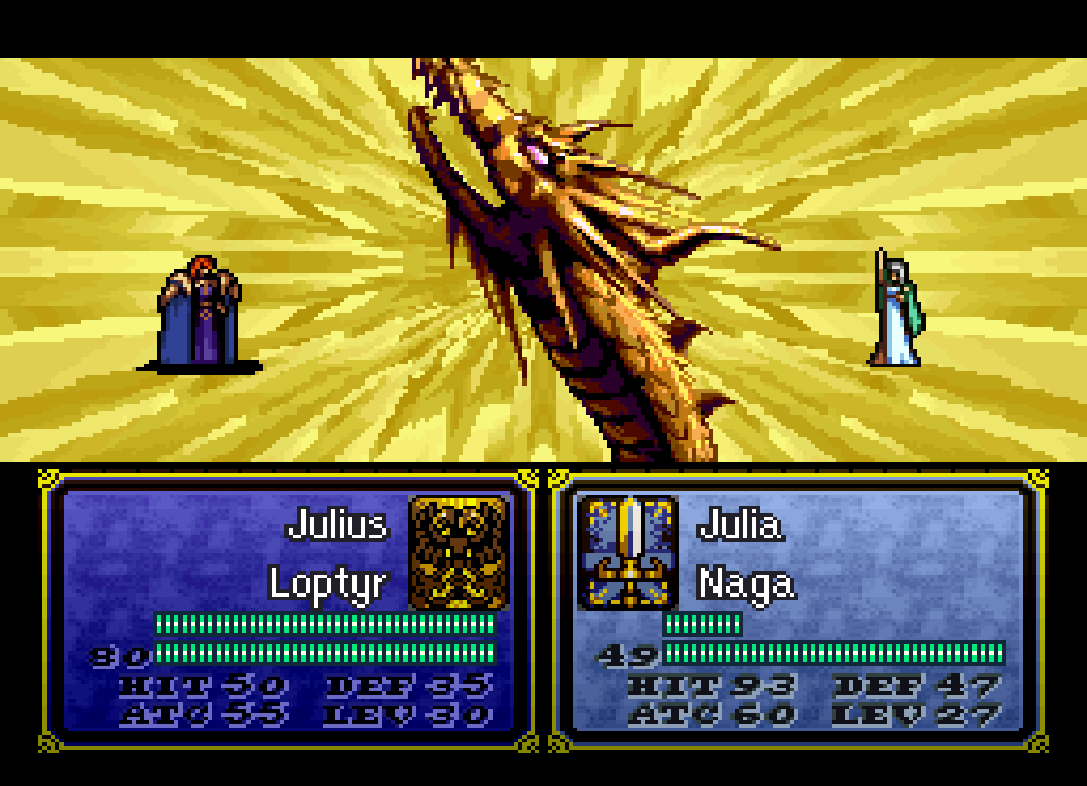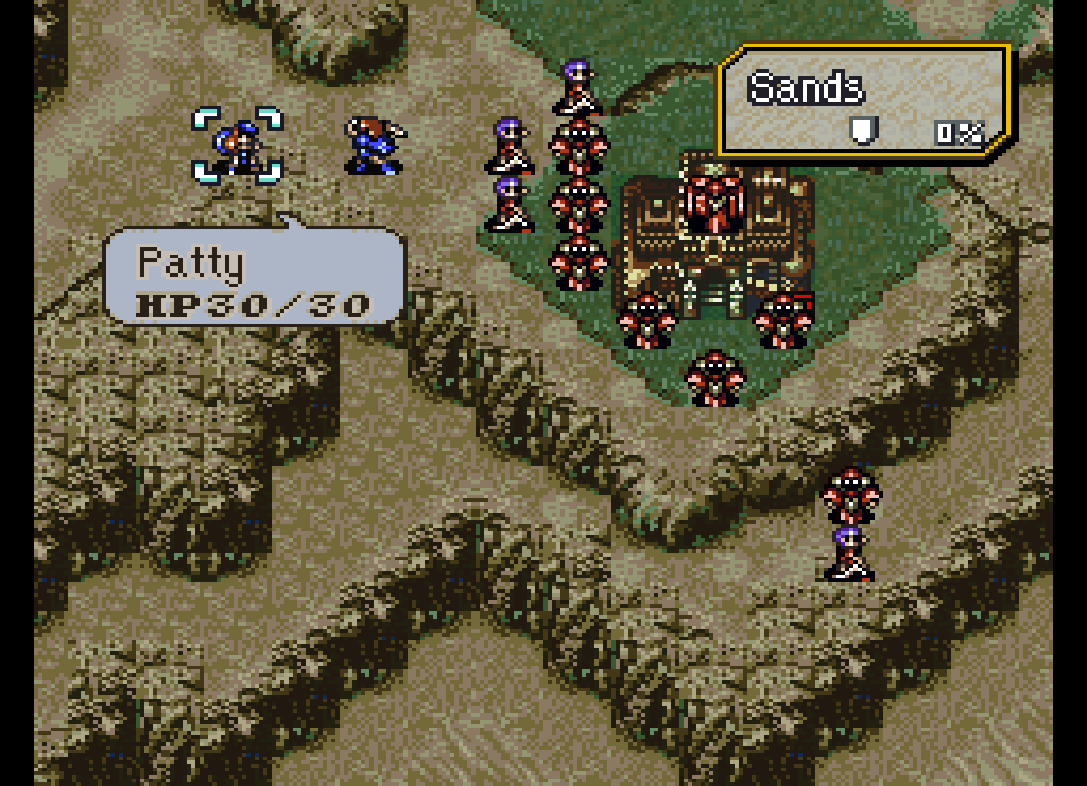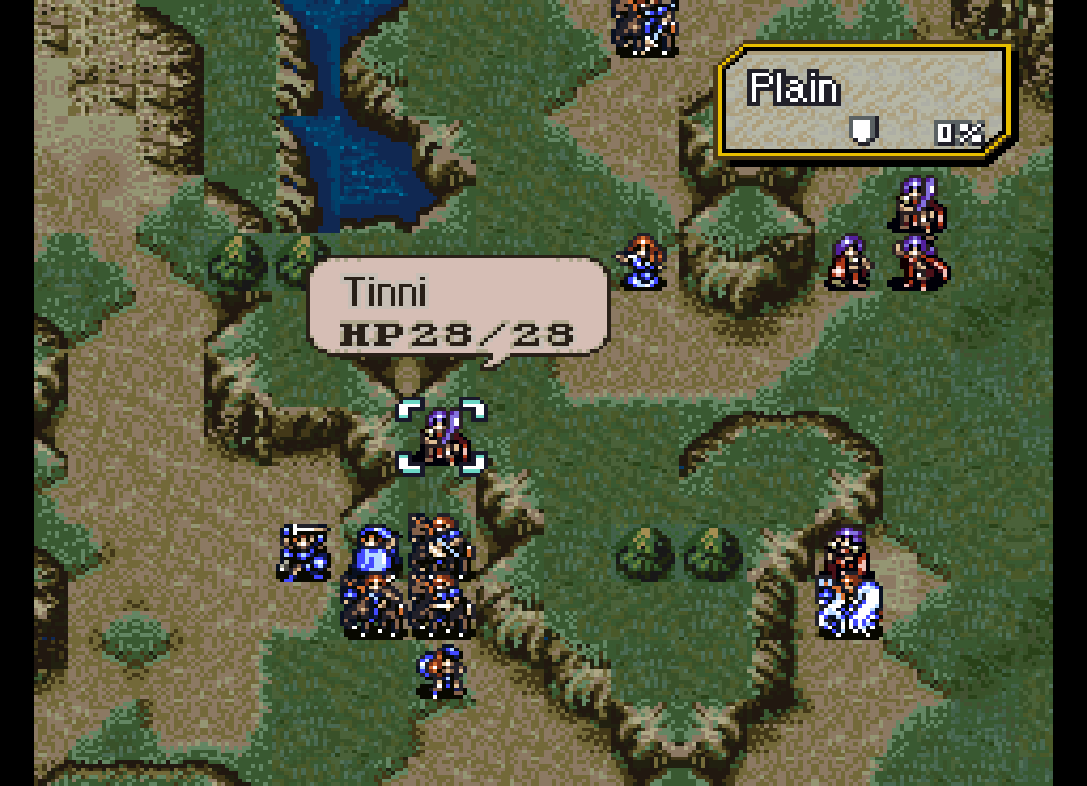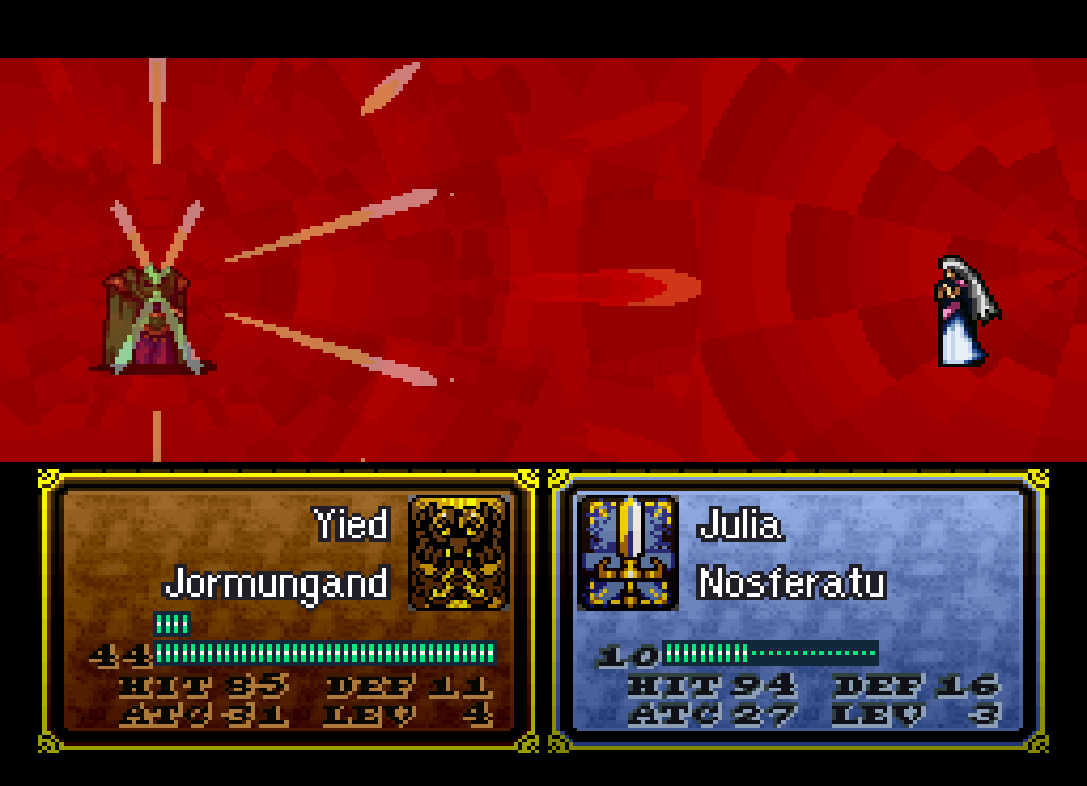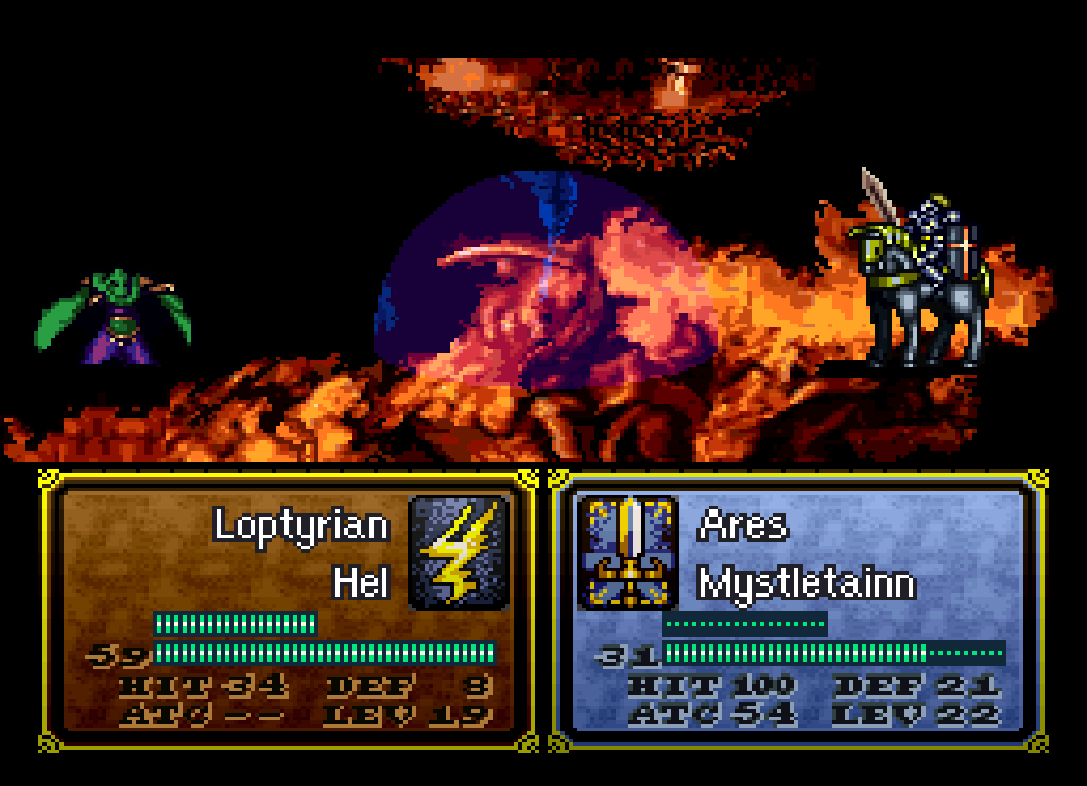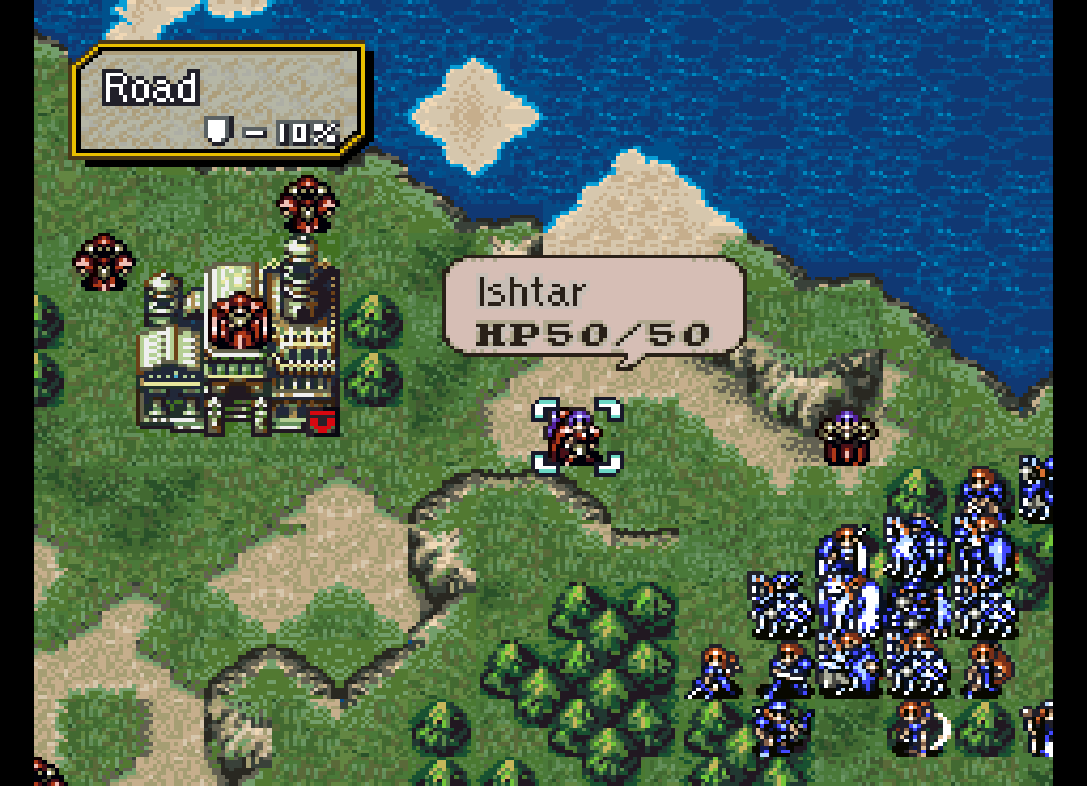NAGA'S BLESSING
Fire Emblem 4's power fantasy of magic resistance
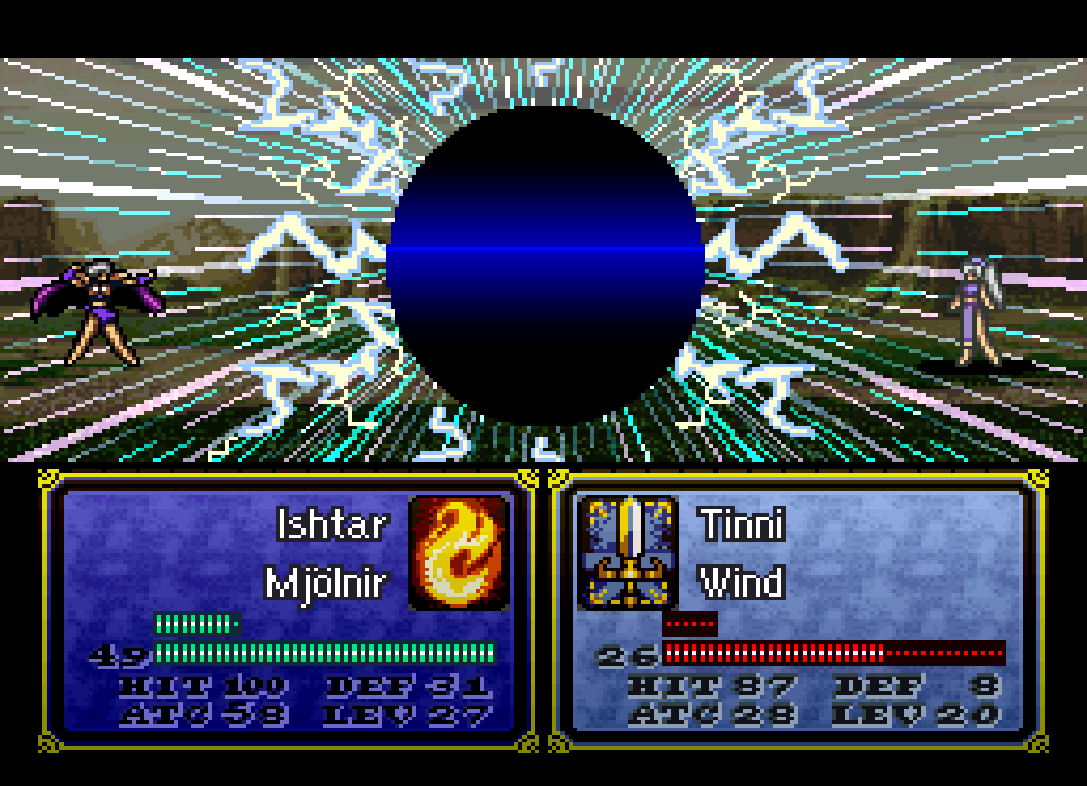 Fire Emblem: Genealogy of the Holy War (FE4)
Fire Emblem: Genealogy of the Holy War (FE4)2600 words. Contains spoilers for the entire game.
Early in FE4, I recruit a silvery Shaman named Deirdre. She's quite powerful: her light magic can kill a lot of enemy units in one shot, and she boasts the highest Res (magic resistance) stat of any character in the game. I haven’t fought any magic-using enemies yet, but that’s about to change as shortly after Deirdre joins I face Sandima, a dark priest whose appearance marks the debut of the Lopt Sect, an evil cult that orchestrates the central conflict of FE4 from the shadows and would eventually take center stage in the story. The raw power of Sandima’s dark magic promises to cut through my knights like butter, and with the long-range dark magic Fenrir in tow, he’s impossible to approach without risking the death of an allied unit. It’s Deirdre that saves the day. Although she uses her Silence staff to render him powerless instead of absorbing the damage with her high Res, Deirdre’s role as a defeater of mages, especially dark mages, sets the stage thematically for the whole game.
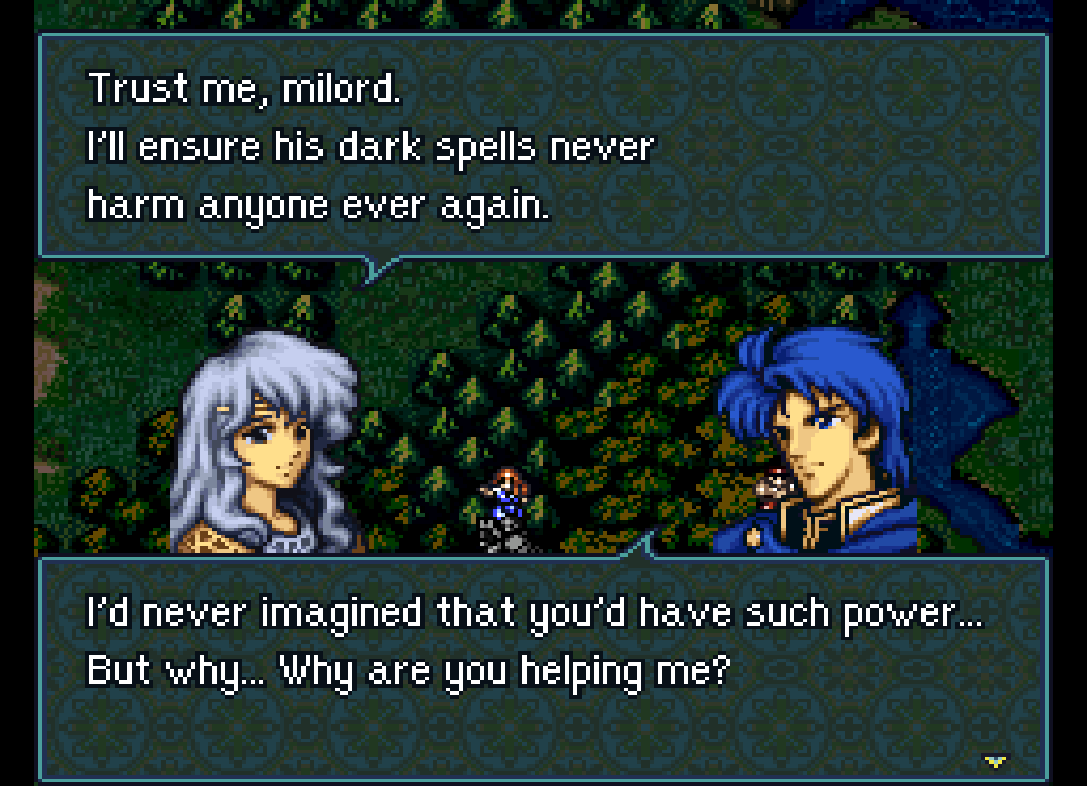
A quick question: Can you think of a time a character or class in an RPG felt strong specifically because of their high magic defense stat? When their ability to resist magical damage led you to choose them over another? I have a nerdy little aesthetic fixation on this. For my own nebulous, idiosyncratic reasons, I think magic defense is really cool. But that feeling is rarely validated through play. In most RPGs I’ve played, defensive stats feel totally subordinate to offensive stats and speed. If resiliency is valuable, it’s a luxury, not an essential; if fragility is problematic, it’s an inconvenience, not a dealbreaker. Especially when random encounters are abundant and minimizing battle length is a concern, the most valuable capacity for a character is damage output, and where defense is concerned, healing supersedes damage mitigation. There are games and situations that are exceptions, but most commonly, feelings of power in RPGs come primarily from your capacity for inflicting damage, not resisting it, with magical defense faring somewhat worse than physical.
Owing in part to its long, high-stakes engagements and spatialized combat, Fire Emblem stands out as a series with a consistent interest in defensive statistics as a form of power. Fire Emblem 4 in particular makes great use of magic defense–Res–as a form of power and an instrument of storytelling. It’s not quite apparent yet in my time with Deirdre, but much of the groundwork is laid then. Apart from her, most allied units (and enemies) have terrible Res. The average character’s Defense score is pretty good (half the characters in the game are mounted knights), with a handful (mostly mages) possessing lousy ones. But the average unit starts with 0 or 1 Resistance and won’t gain more than a couple points more. A couple units might have okay Res, but characters with enough to really shrug off enemy mages come once or twice in a generation. The only teammates of Deirdre’s that can compare in this respect are priest characters with far less potent and ready access to attack magic. Deirdre immediately stands out for the ability to resist magic attacks while dishing out damage herself.
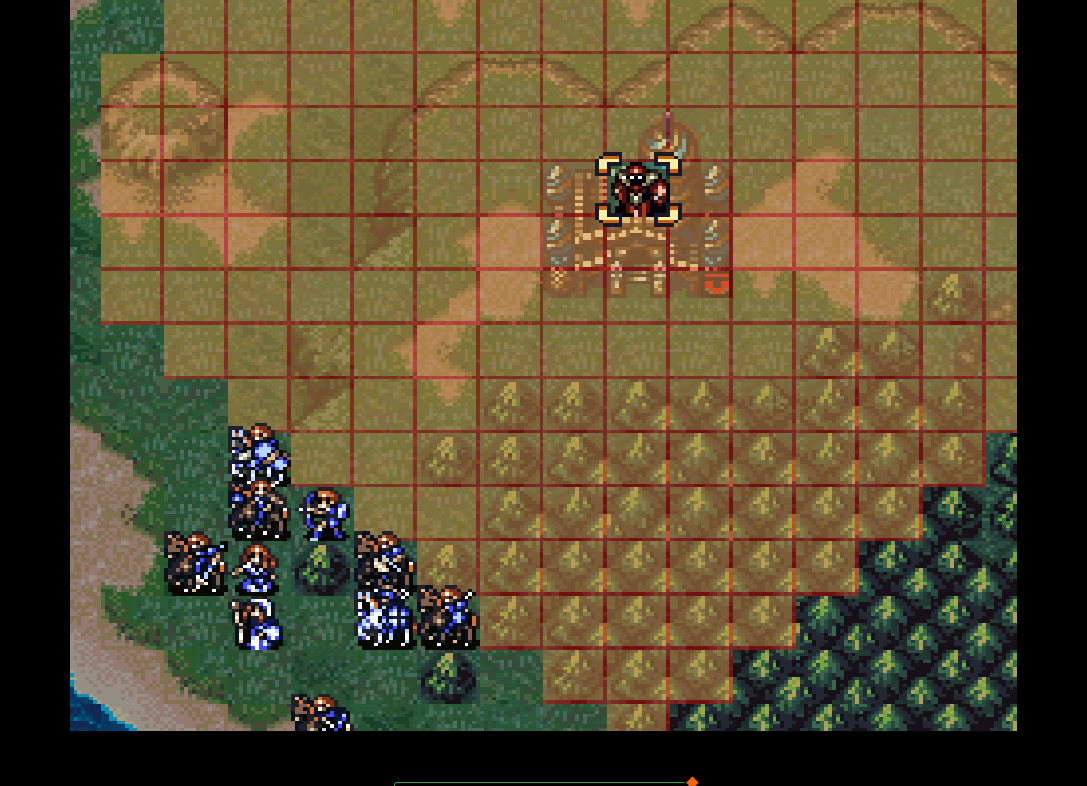
Unfortunately, Deirdre doesn’t get much of a chance to benefit from her talents. A chapter and a half after joining, she’s kidnapped by the Lopt Sect. Sigurd and his noble army will spend the rest of the game’s first half searching for her. In the time Deirdre was under my control, I faced very few magic-wielding enemies, just Sandima and one other minor boss. It isn’t until she leaves that enemy mages start to show up as regular enemies or in significant numbers. Without a high-Res attacker, I fall back on cruder methods: trying to overwhelm mages before they can kill me, playing the odds with high-Avoid units, and selectively accepting some heavy HP loss. The value of high-Res attackers becomes sharply apparent as the supply of magical enemies rises.
Indeed, this rising tide of enemy wizards would introduce me to most of the game’s major villains. I wouldn’t realize the full extent of it until later, but the game would begin revealing them shortly after Deirdre’s departure. In addition to the Lopt Sect, I clashed with thunder-aligned House Freege and fire-elemental House Velthomer, whose armies manned the mid-game climax, and whose noble members would dominate the plot and the battlefield across the back half of the story. All of these noble members eventually faced me in battle, and all of them were mages. With so many high-profile enemy wizards to fight, the ability to confront magical threats and emerge victorious isn’t just strategically crucial, but underscores a character’s narrative weight, too.

Deirdre never returns to my party, but shortly into the second half of the game I meet Julia. Julia is Deirdre 2.0: She starts off a little weaker, but quickly outpaces her predecessor with better stats and the ability to hit multiple times per bout, crucial in any FE title but restricted to certain units in 4. Like Deirdre before her, she sports the highest Res of any unit on my team, bar none. But unlike Deirdre, Julia joins just before a swell in spellcasting enemies, cutting her teeth on the Lopt Sect cultists as they start crawling out of the shadows and on the lightning-slingers of House Freege taking to the field in greater numbers than ever. With magical threats abounding, Julia gets to show off her Res like Deirdre never did, hitting harder, growing faster, and filling a more urgent niche.
So of course it stings even worse when, when, in the game’s penultimate chapter, Julia gets kidnapped, too.
Just like with Deirdre, Julia’s departure is met with a marked increase in enemy mages. In Julia’s case it’s very pronounced. Immediately after she leaves at the start of Chapter 10, a whole squad of dark mages turns on my doorstep, armed to the teeth. Lopt Sect wizards continue to feature throughout the chapter more heavily than ever before in a series of situations seemingly designed deliberately to make me feel Julia’s absence. Without her I’m forced to fall back on riskier options for dealing with them. Julia’s closest competition in Res is Ares, a Cavalier who boasts maybe less than half as much base Res, and only comes close to Julia’s score with the help of a holy sword that grants him an additional 10 points. Any other unit on my team would be lucky to survive two hits from an average dark mage.
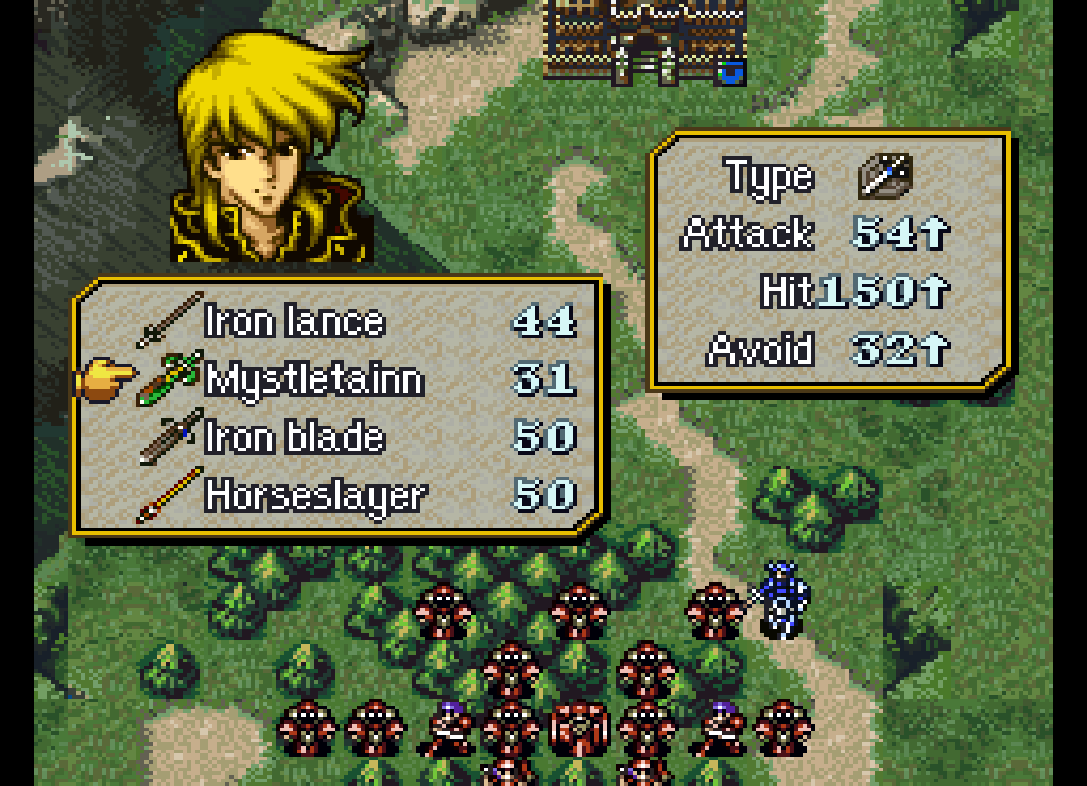
With Ares carrying my team on his black-plated shoulders, I anxiously soldier on through the chapter, holding out for some sign that Julia would return, capturing castle after castle only to find each time that she was nowhere to be found. Each cutscene raises my hopes and dashes them again, and every time I inch closer to her, the plot yanks her farther away again, dangling my precious wizard-slayer just out of reach. Meanwhile, Lopt Sect cultists rain Fenrir on my helpless warriors from ten tiles away, just like Sandima in his castle did at the beginning of the game. Soon the final chapter arrives, Julia’s true plot significance is revealed, and the other heroes discuss the importance of getting her back–but Julia remains offscreen and out of reach as the endgame sets up yet another army of cult magicians for me to endure.
Only in the very last objective of the final chapter does Julia finally resurface. My trial, however, is far from over. Her eyes now glowing red and her dialogue in all caps, I discover Julia has been brainwashed by Manfroy, leader of the Lopt Sect, and now joins the fray not as my saving grace but as an enemy, racing toward me each turn and bent on attacking anyone within her attack range. Her offensive power poses a deadly menace to my own units, matched only by the threat that she might get herself killed in a counterattack. My only choice is to take initiative and break the spell before she puts herself in a position where someone’s death is unavoidable. Racing to cleave through the intervening armies as quickly as possible, I finally clear a path to Julia only to discover that talking to her is useless. She’s too far gone to listen to reason. The spell has to be broken at the source: I’ll have to destroy Manfroy first. Of course, his castle stands on the far side of the plain where Julia’s making her mad advance. Carefully negotiating units around her threat radius, I send a detachment to besiege Manfroy’s castle behind her back (a tactical callback to Chapter 1, where I used a similar strategy to recruit Ayra). Behind me, the units who lagged too far behind to avoid Julia’s wrath flee back the way they came. Meanwhile, having cleared Julia’s range, my main force burns rubber to assault Manfroy and his personal guard, risking disaster to seize his keep in as few turns as possible, before finally sending my leader Seliph–Julia’s half-brother–halfway across the map to chase her down and speak with her again. This time it works–finally. Finally! After all this time and hardship, Julia with her massive Res stat is back on my team, just in time for the final confrontation with Julius and his elite guard of Deadlords. I would have liked her back sooner, but the ultimate confrontation still lies ahead of me: Julius is not only a dark wizard of unparalleled power but also Julia’s full-blooded brother. Both strategically and thematically, the last fight is Julia’s.
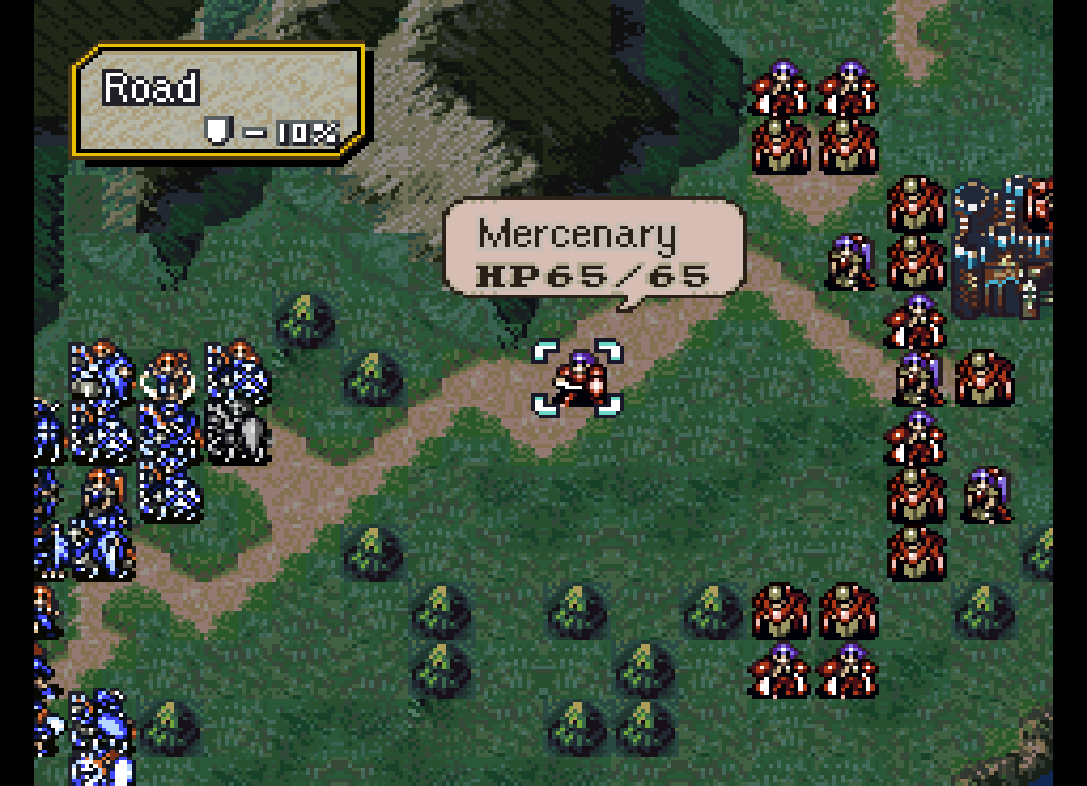
Of course, this has been the game’s plan all along. Julia’s existing power on its own may well have been sufficient to defeat Julius, but that wouldn’t have been climactic enough for the final battle. To put the finishing touch on the moment, after Julia returns to the team, the game bestows me with the Book of Naga, the ultimate light magic tome which Julia alone has the right and power to wield. The holiest of holy weapons, Naga not only dwarfs Julia’s existing spellbooks in raw power but offers her an enormous boost to Res, rendering the power of Julius’ equal-but-opposite Book of Loptyr practically harmless. Receiving and deploying Naga, whose spectacular, elaborate attack animation consumes the screen with the light of an enormous golden dragon, is the crowning moment of the whole war. Julia makes short work of Julius in a match that was one-sided by design, a resplendent, cathartic beatdown that serves as the coup-de-grace after moving heaven and earth to reclaim Julia and her legendary weapon. For Seliph and his liberation army, the work of victory is rescuing, equipping, and positioning Julia to deliver the final blow. For Julia, it’s about surviving Julius’ attacks so she can launch her own. When she defeats him, when she strikes the blow that liberates Grandbell and restores peace to Jugdral, it’s not just because of her attack score (huge, incidentally) but because of her astronomical magic Resistance–the form of power that FE’s design had been impressing the importance of since Chapter 1.
So at the core of FE4’s plot, a familiar routine of light triumphing over darkness, is the elaborate assertion of magic defense as an indispensable form of functional power. FE4 gave me every reason to value Res, taught me to depend on it, took it away when I needed it most, made me miss it dearly, made me wait, wait, wait to find out if I would ever get it back–and when after much time and struggle it finally returned to my arsenal, it did so in such grand and dramatic fashion it defined the climax of the entire game. In short, it was the perfect power fantasy of magic defense, imbuing the Res stat with unique strategic and narrative importance. A complex, long-evolving relation with the object of my fascination, full of tension and release, desire and fulfillment, teeth-gritting lows and explosive highs, all turning on an individual mathematical measure of how well a person endured elemental and spiritual attacks: This is about the richest experience of a basic magic defense stat I could ever hope to sink my teeth into.
I’ll admit again that my love of magic resistance is idiosyncratic; I loved the role it played in FE4 less for its thematic or emotional resonance (it’s not that deep) than for the fact that it scratched my personal brain itch. I think magic resistance is fucking cool, and I wanted a game to agree with me for once. You can dig a little deeper than that, but my excitement at having my tastes validated in such grand fashion accounts for most of my motivation to share what I’ve said here.
But digging just slightly deeper, there’s another, slightly more complicated brain itch it scratches. It happens that I harbor personal affection for a lot of RPG gameplay traditions and devices. One tradition I’m especially fond of (probably more relatably) is class systems. With my love of this comes a fascination with comparisons and contrasts. The broad distinctions between classes are easy to notice and appreciate, but the fine ones matter, too. It’s exciting to have two similar classes, two different strategies for achieving the same purpose, that differ in their subtleties. There’s a need somewhere deep inside me that seeks to become invested in these minutiae and benefit from them; chewing on them is almost inherently pleasurable to me in a way that underlies, well, a lot of my fascination with RPGs in the first place. A model that collapses power or effectiveness to a single variable like damage per second seeks to undermine this pleasure. I would much rather have two “fighter” archetypes at my disposal and value them both for different reasons–for their situational or methodological differences in fulfilling that purpose, not just because I want two fighters worth of physical damage output.
The structure this desire needs to be fulfilled is a holistic model of power. Under such a model, many forms of power exist simultaneously and none can be dismissed without consequence. FE4 fulfills this, or comes close to it, by fulfilling the promises of its character stats–that almost every one matters for every character. That is to say, there are few if any “dump stats”. A high number typically represents a tangible strength for a character, and a low one a tangible weakness, even if those aren’t the central stats. Attack and Speed might be the most important stats for a physical attacker, followed by HP and Defense, but I still had cause to appreciate high Skill, Luck, Magic, and Res scores when they popped up on my knights and swordsmen. Even though none of them needed these secondary stats to perform their core duty, a unit that excelled in one of them felt powerful in a way that distinguished them from their peers and deepened their sense of identity. This is an important notion for FE4: The breadth and definition of character identity as expressed through combat stats (and especially through character skills) is one of FE4’s most unique triumphs as a large-cast RPG, and a key part, I think, of how its characters took on such a mythical quality. Magic defense is just one small part of that triumph, but the story that the game tells through and about Res speaks to an underlying ethos: Even in war, power takes many shapes, and to confine yourself to too narrow or simplistic an understanding of it is deadly.
